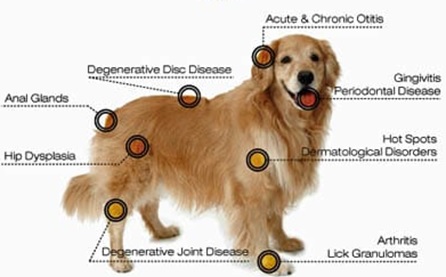Pet Cold Laser Therapy
Modern veterinary medicine uses laser therapy to treat various conditions in animals, including chronic pain.

Pet Cold Laser Therapy
What is this therapy, and how can it help my pet?
Cold laser therapy uses a laser light concentrated on an area of inflammation or pain. As the name suggests, this laser cannot cause a burn or heat due to the wavelength of the light, making it very comfortable when used on our pets.
The laser works by introducing light to inflamed tissues at a particular wavelength allowing it to penetrate the cells of the tissue. This causes the cells to increase their metabolism, thereby helping the cells to speed the creation of the building blocks needed for tissues to heal. Cold lasers use this targeted wavelength of light to create an anti-inflammatory healing effect known as “phototherapy.” Cold laser therapy has been shown in both human and animal medicine to:
- Speed healing
- Reduce inflammation
- Reduce pain

When can Cold Laser Therapy be used?
Cold laser therapy can be safely used to aid in the treatment of a variety of different inflammatory conditions in our pets.
One of the best characteristics of cold laser therapy is that it can be safely used for pets with underlying diseases that may limit the types and doses of pain medications or anti-inflammatories needed to keep them comfortable. Pets with kidney disease or liver disease can safely undergo cold laser therapy to treat wounds or arthritis, which can lessen the amount of oral medication needed to reduce their pain in most instances. It can also be used postoperatively to speed healing and decrease pain or inflammation. This allows for a safer, more natural multi-modal pain control approach for your pet.
See the photo for common areas that we laser on pets:
Is Cold Laser Therapy Ever Unsafe?
Cold laser therapy can treat any inflammatory condition in our pets, with one exception: Cancer. Because the laser promotes cell healing and cell division, if the laser is used to treat an area containing cancerous cells, it will also promote their growth.
It’s always best to perform a workup before starting cold laser therapy to rule out any cancerous process as the cause of the inflammation being treated for this reason. This may involve biopsies of tissue or x-rays of affected areas.
What is Involved in Cold Laser Treatment?
This is a difficult question, considering that every pet is different and will likely need tailored laser treatment schedules.
We will start the cold laser therapy treatment with an examination by one of our doctors to assess your pet for areas of pain and inflammation. Based on this exam, we determine your pet’s best course of treatment. A technician will administer subsequent laser treatments, and doctor consultations can be scheduled as needed throughout the treatment course to address any concerns.
We start our treatment course with a “3,2,1 Protocol,” commonly used for first-time patients with more chronic conditions such as arthritis. For this protocol, we will see your pets three times for the first week, twice the second week, and once the following week. The laser is applied to the areas needing treatment for 3 minutes each during each session. After this initial course, we will re-evaluate your pet to determine the success of the laser treatments. If the treatment needs to be adjusted, it will be done at the end of the 3,2,1 Protocol. Most of the time, performing laser therapy on the affected areas once per week to once every other week on a long-term basis can help pets greatly, depending on their individual needs.
For pets with wounds, laser treatments are more frequent than with more chronic conditions and can be as frequent as every day to every other day based on the severity and level of infection of the wound.
Please contact us today to book your pet for its first laser treatment. We look forward to helping you heal your pet!
Veterinary Services
Below are all of the veterinary services we offer at Heartlake Veterinary Hospital. If you have any questions regarding our services, please feel free to call us.
